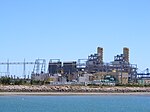Pelican Point Power Station

The Pelican Point Power Station is located at Pelican Point, 20 km from the centre of Adelaide, South Australia on the Lefevre Peninsula. It is operated by Engie (previously known as GDF Suez Australian Energy), which owns 72 per cent of the power station. Mitsui owns the remaining 28 per cent. It burns natural gas in a combined cycle power station, comprising two 160 MW gas turbines and one 165 MW steam turbine, to generate up to 485 MW of electricity.Construction began in 1999. The plant has two GT13E2 gas turbines manufactured by ABB (now Alstom). The plant, including steam turbine and heat recovery steam generator (HRSG), was manufactured and constructed by ABB. Fuel is supplied via either the SEAGas pipeline, which runs from the Iona Gas Plant in Victoria to the Pelican Point power station, or the Moomba Adelaide Pipeline System (MAPS), which supplies gas from Moomba to Adelaide.
Excerpt from the Wikipedia article Pelican Point Power Station (License: CC BY-SA 3.0, Authors, Images).Pelican Point Power Station
Pelican Point Road, Adelaide Outer Harbor
Geographical coordinates (GPS) Address Nearby Places Show on map
Geographical coordinates (GPS)
| Latitude | Longitude |
|---|---|
| N -34.763055555556 ° | E 138.505 ° |
Address
Pelican Point Road
Pelican Point Road
5018 Adelaide, Outer Harbor
South Australia, Australia
Open on Google Maps









